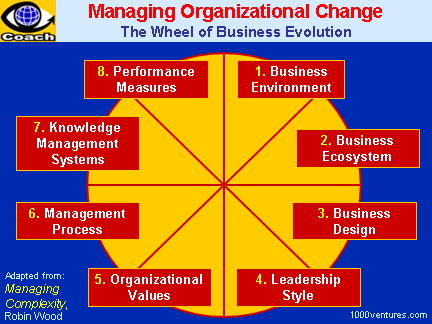
|
Three
Major Stages of Organizational
Evolution1 |
-
Bureaucratic:
strategy is not emphasized; hierarchical structures; linear focus;
dehumanized
-
Complex: quantitative strategy;
laterally complex structures; bifurcated, conflicting focus;
limitations of workforce performance
-
Adaptive: visionary,
human strategy, simpler in context structure; work/family
integration systems; capability and efficacy of workforce
|
|
Common Characteristics
of Complex Evolving Systems1 |
|
Five operational
characteristics
-
Self-organization
– enables different possible combinations of ideas and relationships
to emerge from the "co-incidences" that happen during informal
interactions.
-
Creativity – emerges from the interaction of the components of
a network; at the human level, the collaboration of a group and
cross-pollination of ideas produces outcomes that are not
possible to predict by simply summing up the behavior of the
individuals involved
-
Non-linearity – small causes produce large effects in human
systems
-
Memory – distributed throughout the system; this history is
critical to the behavior of the whole system
-
Adaptability – can reorganize their internal structure without
the intervention of, or in response to the intervention of, an
external agent; it is a result of unconscious learning (tacit
knowledge) that may enable the system to have a higher
probability of survival under changing conditions in its
ecosystem
and
environment.
Four human
relationships and organizations' characteristics
-
Being
– the in which people, who have authentic presence and needs,
experience themselves in an organization can enable or constrain the
potential of what an organization can become.
-
Identity – is a function of interaction of persons' being and
their relationships; is a strong driver of the organization's
outcomes. Innovation, for example, is possible only in a
collaborative environment that creates the conditions for creative
thinking.
-
Conscious learning – whether
knowledge
is created and shared in an organization will depend on the quality,
number and types of relationships within an organization, and
between the organization and its
ecosystem.
-
Coherence – requires an alignment of context, viewpoint,
purpose and action that enables further action.2
The extent to which organization operates as a network of
relationships enables individuals to make sense of their work and
their world, and will strongly influence the
coherence
of the organization and its sense of purpose.
|
|
Balanced Organization: 5 Basic
Elements
Wood (Corporate
Capabilities):
The Growing Role of the
Business Architect
In today's knowledge- and innovation-driven
complex economy,
business architects
are in growing demand. They are
cross-functionally excellent people who can tie several silos of
business development expertise together, lead
business innovation,
create
synergies,
design winning
business models and a
balanced business system
and then
lead
people who will put their plans into action...
More
Systems Thinking
Systems thinking is your ability to things as a whole (or holistically)
including the many different types of relationships between the many
elements in a complex system. "Systems
thinking is a sensibility – for the subtle interconnectedness that gives
living systems their unique character."11...
More
Cross-functional Management
(CFM)
Cross-functional management (CFM)
manages business processes across the traditional boundaries of the
functional areas. CFM relates to coordinating and
synergizing the activities of
different units for realizing the superordinate cross-functional goals and
policy deployment. It is concerned with
building a better system for achieving such cross-functional goals as
innovation,
quality,
cost, and delivery...
More
Right Balance
Between Structure and Chaos
Chaos is
paradoxical; you need a certain amount of chaos to be creative but not to
the point that you feel overwhelmed by its amount.
Too much uncertainty discourages people from mobilizing their best effort.
Direction and purpose and a certain amount of structure create freedom.
People feel liberated by goals and guidelines.
Successful organizations must
balance structure and bureaucratic processes at one extreme with the
fluid
creative chaos of relationships,
interests and transactions, which enable it to be
innovative
and alive, at the other...
More
7Ss – a Managerial Tool for Analyzing and Improving Organizations
The Seven-Ss is a framework for
analyzing organizations and looking at the various elements that make them
successful, or not. The framework has seven aspects:
strategy;
structure; systems; style; skills; staff; and
shared values.
The theory helped to change
manager's thinking about how companies could be improved. It says that it is
not just a matter of devising a new strategy and following it through. Nor
is it a matter of setting up new systems and letting them generate
improvements. To improve, companies have to pay attention to all seven of
the Ss at the same time. All seven are interrelated, so a change in one has
a ripple effect on all the others. Hence it is impossible to make progress
on one without making progress on all...
More
|